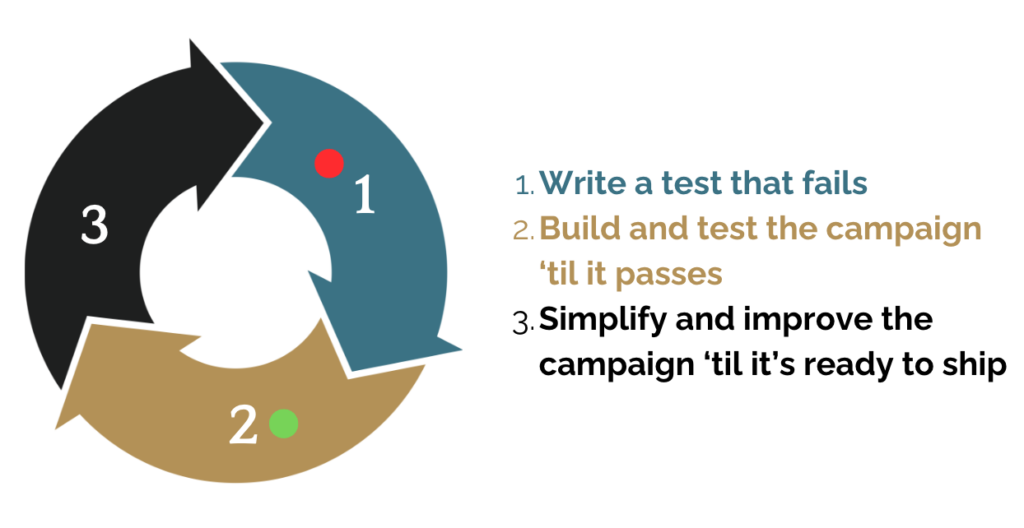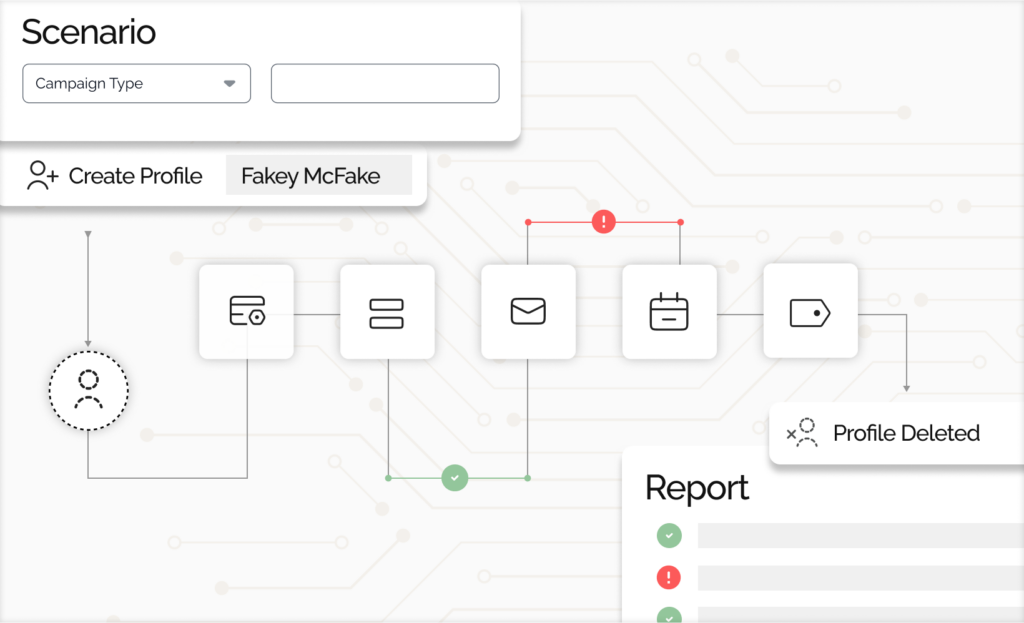What is Test-Driven Marketing (TDM)?
Welcome to Test-Driven Marketing, a new way of adopting Agile principles to increase campaign quality and operational excellence. This is not a completely new concept. It’s borrowed from the world of software engineering, where Test-Driven Development (TDD) is a widely accepted practice, Test-Driven Marketing incorporates testing as a core principle for building, launching, and maintaining campaigns and other marketing assets.
No, this isn’t A/B Testing. It’s about quality tests that validate that everything works through all of your marketing campaign phases. If you care enough to build it and launch it, you should care enough to test it.

How does it work?
First, start by failing
TDM starts by writing a test that fails. Because of course the campaign doesn’t exist yet. For example, the test could create a lead using synthetic data, which is expected to end up in a particular campaign with a particular lead stage, and lead score.
Second, you pass the test
This step is all about building a campaign that can pass the test. That means for example, you need to understand the audience segmentation, the data strategy, the offer, the CTA, and the flow of the lead through your system to becoming a campaign member with the correct response type.
Third, you fine-tune the campaign
Now that your campaign is passing the test, you’re ready to complete it. Maybe you can simplify the workflow, or add new variations or assets. Maybe you can speed up the delivery to sales. And of course with every iteration of campaign phases, your test is ready to validate your work
And that’s it! Now, when you launch your campaign, it launches along with a test that can be run at any time to validate that the campaign is still operational and error-free.
How is Test-Driven Marketing different from A/B Testing?
A/B Testing (or multivariate testing) is scientific experimentation in order to optimize your marketing campaigns. You create a campaign with one or more variants, and then test to see which result has the better desired outcome.
Test-Driven Marketing is not about variants. It’s about quality. It’s about shipping campaigns that are proven to work as expected because a QA (Quality Assurance) Test is built along side the campaign and used to validate that it is working. And after the campaign ships, the test can be used for monitoring and diagnosis to keep it working as intended.
Can Test-Driven Marketing and A/B Testing be used together?
Absolutely! The two testing frameworks are complimentary. Test-Driven Marketing is especially critical for scientific marketing where you need to measure lift across variants. Any marketer who is running experiments should start by making sure that the control campaign and the variants all pass a QA test.
Why should marketers embrace TDM?
Studies in software engineering have shown that a test-driven process may reduce initial productivity (slowing down work by about 15%), but can reduce errors exponentially (2.6X-4.2X reduction in errors). TDM also results in time savings on documentation, since a test is a robust form of documentation.
Here are some of the benefits of TDM for marketers and marketing operations
- Design clarity. By starting with the test, you will know you have created a campaign that has process and outcomes defined.
- Simpler campaigns. Campaigns that pass a test are easier to measure, maintain, evaluate, and clone.
- High marketing coverage rate. Your new quality score! When more campaigns ship with a test, you will increase the percentage of your marketing program that has been tested and validated.
- Improved productivity. Problems are easier to diagnose, fix, and update.
- Better documentation. Every time you run a test, you indirectly document your marketing stack. This saves time during audits, diagnosis, and retrospectives. And it reduces technical debt.
- Embrace the Agile. Welcoming change to increase the quality of your marketing program is a key Agile principle. Testing brings about changes that increase campaign quality and operational excellence.
- Increased ROI. Campaign building may slow down at first. But ROI quickly follows. Maintaining campaigns gets easier and faster. More of your existing campaigns keep producing. And on average, marketers with full testing coverage discover 5-7% lift in leads from existing campaigns, due to incorrect data or misrouting. And studies show a massive reductions in errors, ranging from 50% to 4.2X, depending on the study.
But maybe the best part ofTest-Driven Marketing is that by starting with the test and front-loading some of the work, you make everything else easier. That same test that you used for campaign design can now power QA at launch time, regression testing, live monitoring, incident diagnosis, and big projects like platform or data migrations. You end up increasing the quality, and lowering the overall effort.
Getting started with Test-Driven Marketing
Like anything new, it can sound scary. But the rewards come more quickly than you might expect.
There are ways to get started manually. But if you want a giant head start, Stack Moxie is the only product that provides full capabilities for any marketing or marketing operations team that wants to dive (or stick their toe gingerly) into Test-Driven Marketing. Features like:
- Build tests at scale with Airtable, Asana, or spreadsheets
- Run synthetic data through your workflows to test different data-driven outcomes
- Leave no trace: test records can be deleted automatically at the end of the test
- Schedule tests to run as frequently as you need to for peace of mind
Get started now with our free app, or reach out to our Sales team to get the conversation going.

